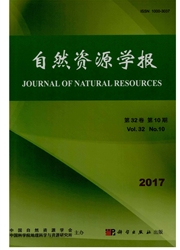

 中文摘要:
中文摘要:
对黄土丘陵区3个不同植被恢复模式沟谷地植被群落的生物量和物种多样性特征进行样方调查,统计分析了不同植被恢复模式沟谷地植物群落的盖度、生物量、物种多样性、植物种群相似系数。调查共记录植物82种,隶属32个科;其中,乔木植物5科,6种;灌木植物8科,11种。经过20a左右的植被恢复重建,不同植被恢复模式沟谷地的植被群落均呈现良好演替趋势;人工植被柠条灌丛和刺槐林恢复模式对沟谷地草本层盖度和群落枯落物盖度及生物量方面作用效果较好;而天然草地对沟谷地草本层生物量方面作用效果较好;沟谷地物种多样性指数表现出人工植被恢复模式效果优于自然恢复,而且人工柠条灌丛植被恢复模式优于人工刺槐林植被恢复模式。柠条灌丛沟谷地不同坡位植物种群相似系数较高,而刺槐林沟谷地和天然草地沟谷地不同坡位植物种群相似系数略低;沟谷地的种群相似系数在沟坡上部略高于沟坡下部和沟底,东坡略高于西坡。人工植被建设可以促进黄土丘陵区沟谷地的植被恢复进程。论文建议在今后黄土丘陵区沟谷地人工植被建设过程中,需要加大乡土树种的引入、提高树种的多样性、合理树种的空间配置和注意灌/乔树种的比例。
 英文摘要:
英文摘要:
Vegetation restoration and reconstruction of the gully area is very important for controlling soil erosion and constructing ecological environment in the hilly loess region. In this study, we choose three different vegetation restoration patterns in gully areas locating in the typical hilly loess region of Ansai County, northern Shaanxi Province. They were Gully 1, Gully 2 and Gully 3, being the Robinia pseudoacacia forest vegetation restoration pattern( artificial arboreal forest), the Caragana korshinskii shrub vegetation restoration pattern (artificial shrub)and natural restoration pattern ( natural grassland) respectively. The gully area was divided into five transects : there were the upper west slope ( Wu), the lower west slope ( W1), the bottom of south-north gully area ( SNb), the lower east slope (E1) and the upper east slope (Eu) respectively. Ten sample plots were randomly set up in each transect. There were 50 sample plots in each gully area, totalling 150 in this investigation. The investigation was conducted on plant species coverage, biomass, species diversity and species similarity coefficient of the sample plots. Based on the investigation, 82 species belonging to 32 families were found. Included were six arbor species belonging to five families and 11 shrub species belonging to eight families. After 20 years vegetation restoration and reconstruction, vegetative succession has presented a better succession trend in three different vegeta- tion restoration patterns in the gully area. The Caragana korshinskii shrub vegetation restoration pattern and the Robinia pseudoacacia forest vegetation restoration pattern had a good function effect in plant community coverage of herb layer and coverage and biomass of community litter; and natural restoration pattern had a good function effect in biomass of plant community herb layer. The species diversity index of artificial vegetation restoration pattern was more effective than natural vegetation restoration pattern in the g
 同期刊论文项目
同期刊论文项目
 同项目期刊论文
同项目期刊论文
 Effects of long-term fertilization and mulch on soil fertility in contour hedgerow systems: A case s
Effects of long-term fertilization and mulch on soil fertility in contour hedgerow systems: A case s The effect of land cover/vegetation on soil water dynamic in the hilly area of the loess plateau, Ch
The effect of land cover/vegetation on soil water dynamic in the hilly area of the loess plateau, Ch The effect of land uses and rainfall regimes on runoff and soil erosion in the semi-arid loess hilly
The effect of land uses and rainfall regimes on runoff and soil erosion in the semi-arid loess hilly Secondary succession and its effects on soil moisture and nutrition in abandoned old-fields of hilly
Secondary succession and its effects on soil moisture and nutrition in abandoned old-fields of hilly 期刊信息
期刊信息
